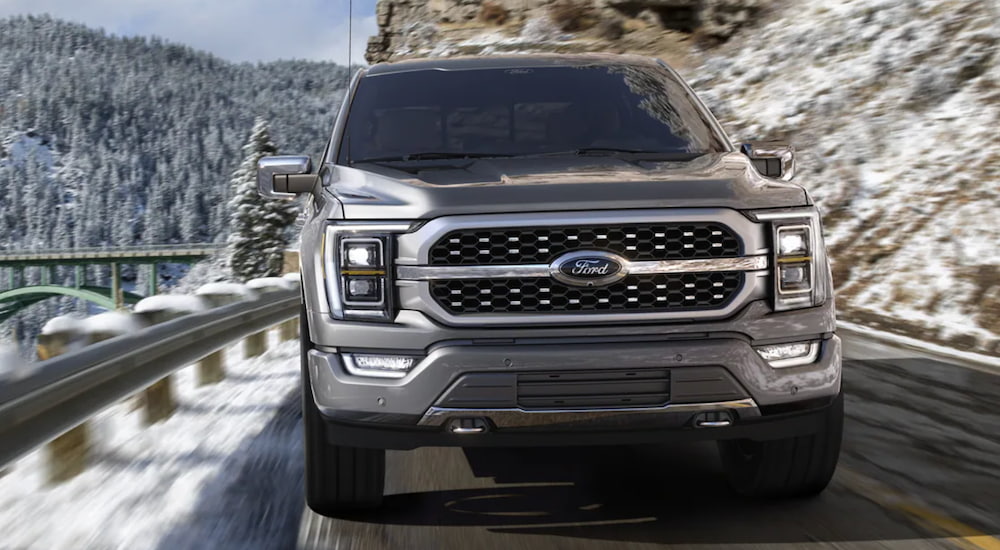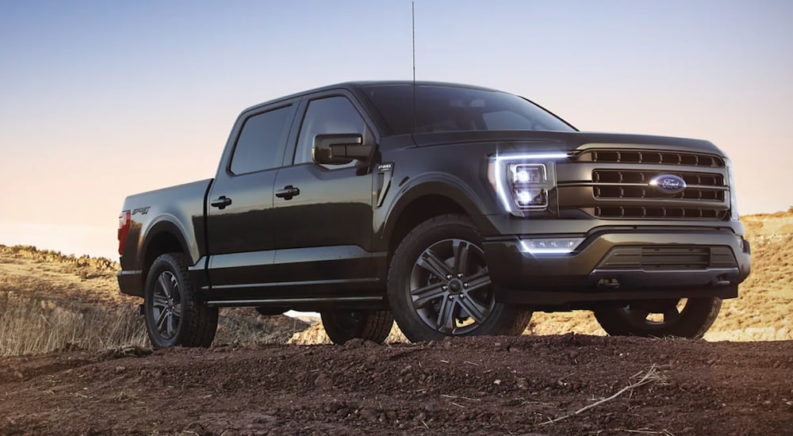The most versatile and capable pickup on the market today can be found at your nearest Ford F-150 dealer, and that versatility is underpinned by the large number of options available for all aspects of America’s favorite vehicle. But while choosing bed size, cabin features and engine are all pretty straightforward, selecting the right drivetrain can be tricky for drivers who are less familiar with how vehicles work.
The drivetrain, or drive system, is how power is transferred from the engine to the wheels. The major parts that make up the drivetrain include the transmission, transfer case, differentials, and axles. Since every configuration of the 2021 F-150 now comes standard with a modern 10-speed automatic transmission, we will be focusing on the other available options.
4×4 vs 4×2
To start with, the first choice to make is deciding between 4×4 or 4×2. Two-wheel drive, or 4×2, drives only the rear wheels and is the simplest and lightest option. Four-wheel drive, or 4×4, locks the front wheels into the rear-wheel drive system to provide engine power to all four wheels. 4×4 is heavier and comes at a higher cost but provides twice the grip of two wheel drive.
That additional grip, especially in challenging conditions or terrain, is why a 4×4 drive system is selected by so many. The term 4×4 is synonymous with off-road capability and traction in difficult situations. A four-wheel drive system does not make a truck invincible and only provides that doubled grip in terms of acceleration, not braking or cornering, but it remains a vital piece of equipment for many.
Because of the capabilities of a four-wheel drive system, some look down on the cheaper and simpler two-wheel drive system also offered for the F-150. However, with appropriate tires for the climate and environment, even a two-wheel drive F-150 will be more than capable of getting around. More importantly, two-wheel drive trucks have higher payload and towing ratings than their four-wheel drive counterparts and burn less gasoline to boot.
Four-wheel drive can be vitally important for those looking for the maximum amount of traction, but for those driving mostly on pavement, lighter and less expensive two-wheel drive is the optimal choice. Match what you need your truck to do to what option you select for it.

Use Cases
More than anything else, the choice of drivetrain should be dictated by what you need your truck for. For most drivers, the vast majority of their time is spent cruising on solid pavement, occasionally in inclement weather. Whether moving around town or cross country, for work or play, four-wheel drive is not actually required. Even in heavy rain, four-wheel drive may make a truck more docile to handle, but it will not impart any large advantage. In snowy weather on unplowed streets, four-wheel drive becomes a true asset. That said, most would be served just fine with snow tires on two-wheel drive pickups.
As a general rule, four-wheel drive is most useful in situations where normal passenger cars would be out of place. On the off-road trail, for example, or moving around off the beaten path on a job site. Any time the driving surface is loose or ungraded, four-wheel drive will come in handy. That is doubly true when hauling a load in the bed or via trailer.
Heavy loads and loose surfaces are definitely not two-wheel drive friendly. Extra weight in a two-wheel drive truck could even lead to the vehicle digging itself into the road surface, while the same extra weight would only give a four-wheel drive pickup more grip. This is assuming the truck is equipped with the correct tires for the situation, but in any case, four-wheel drive is the only choice for those who often find themselves on unprepared surfaces.
Differential Types
A differential is a drivetrain part that transfers power from a driveshaft to the axles. The F-150 offers different types of differentials for various applications, all of which can be useful depending on one’s needs. The three different types of differentials offered on the F-150 are the Torsen differential, an electronically locking differential, and an open differential.
The least expensive and most common option is an open differential. These differentials allow wheels to turn at different speeds when the vehicle is turning, reducing tire wear and noise. However, on slippery surfaces, the wheel with the least grip gets all the torque, leading to excessive wheelspin. These differentials are best for those not intending to leave hard pavement.
A Torsen differential is a mechanical differential that uses gearing to supply power to the wheel with the most grip, the exact opposite of an open differential. Torsen differentials are best in applications where maximum grip is required, even if they are more expensive. The F-150 Tremor has an optional Torsen front differential.
The most versatile differential option available on the F-150 is the electronically locking differential. These “lockers” allow maximum capability and traction on loose surfaces and are ideal for offroading and other enthusiast applications. These differentials can completely lock at the touch of a button, forcing all wheels to spin at the same rate. This capability is extremely useful when dealing with difficult terrain. What makes electronically locking differentials so versatile is that they can be unlocked with that same touch of a button, preserving perfect on-road drivability and comfort.
Axle Ratios
Finally, we have the final drive ratio, also known as the axle ratio. This gearing augments the transmission’s ratios to help better serve a specific purpose. As a general rule, the higher numbers are focused on delivering power, while the lower numbers have better fuel economy. A balance of both is required in any application, but as one would expect, an owner’s requirements could heavily favor one attribute over the other.
There are several different axle ratios available, though the selection will depend on the chosen engine. Most of the engines are available with 3.55 and 3.73 axle ratios, both of which offer a good mix of efficiency and acceleration. The 3.73 gearset is actually the most aggressive option available on the 2021 F-150. The 5.0L V8 is the exception and can be ordered with either a 3.73 or a 3.31 gearset. The 3.31 might sound overly efficiency conscious, but because of the Coyote V8’s significant torque output, this ratio delivers both impressive acceleration and impeccable highway cruising efficiency.
Overall, just like all other feature selections, pick the option that best suits what you want to use your F-150 for.
Spec Your F-150 Right
The F-150 can be precisely configured to suit your personal needs in many different ways, but especially in terms of its drivetrain and drive system. Four-wheel drive and two-wheel drive each have their ideal use cases, and there many owners whose needs are perfectly fulfilled by one or the other.
Picking the right differential might be easier than selecting the right drive system, as Torsen, electronically locking, and open differentials have specific strengths that tailor them to certain kinds of driving. Axle ratios determine the truck’s focus on acceleration, efficiency, or an even mix of both. No matter what you need, the F-150 can make it happen.





